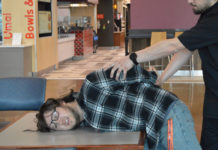A big problem that many face in the gym is losing their grip. The muscles being worked during resistance training may still have strength in surplus, but are unable to be pushed to their potential because hands are unable to maintain their hold on the bar. The solution to the problem is actually quite simple. Learn to let go a little.
Consistent tight squeezing of the bar will wear out grip strength fast. Essentially it involves maxing out grip pressure every set. It is no wonder that doing so leads to the inability to hold on. That is where letting go a little will increase gym performance.
Obviously letting go entirely means dropping the weights. Gym patrons with grip issues already do that.
In one case, they might break the gym rules and throw etiquette out the window by allowing weights to slam. That disrupts the workouts of others and leads to unnecessary wear and tear on gym equipment.

That behavior is disrespectful and destructive. It betrays an utter lack of consideration for people and property, and has no place in a civilized society.
In another case, they might have to set the weight down before they lose control and either shake the burn-off or terminate the set at that point. That disrupts the flow of their workout and may lead to decreased benefit from exercise.
Therefore, both cases being considered, letting go entirely is not recommended as the solution to failing grips in the gym.
Letting go a little means relaxing the grip to take the focus off how tightly a bar can be squeezed and placing it where it belongs: working the target muscles to their maximum potential.
Relaxing the grip will allow gym patrons to reach the end of their workout without losing their ability to hold onto the weights.
There are a few different ways to do this. The first technique involves the use of gravity. When lying supine with arms up and supporting the load, there is no need to squeeze the bar or dumbbells.
The bar will sit perfectly fine in the nook between the thumb and fingers while resting on the meaty portion of the palm. Proper form will have the wrist stacked directly over the forearms, thus creating a stable supporting platform.
In this setup, the fingers can relax and allow the primary muscles to do their work of raising and lowering the weight. There is no need to hold on tightly and pull the weight toward the ground. Gravity doesn’t require help.
Another position involves standing and curling weight upwards. The only time grip ought to be a concern is when performing the move in reverse-grip where the palms face the ground. In a natural grip of palms facing up, the palms will provide the necessary platform for the weight.
On full downward extension, flexion of the forearms and a slight curl of the relaxed fingers will provide a cradling action for the weight. A side benefit of this technique is the manner in which it engages the forearm muscles and turns a simple curl into a compound movement.
A similar technique to the two previously mentioned can be applied to cable machine exercises. In pushing moves, the grip can be relaxed while the palm-wrist-forearm platform supports the weight. In pulling exercises, forearm flexion will help hold the weight where it needs to be.
In situations where forearm flexion is not enough to support the weight involved and full extension takes place, such as shrugs, deadlifts and pull-ups, a thumb wrap technique may be employed to prevent the need for squeezing tightly.
This is done by wrapping the thumb around the bar first and then wrapping the fingers around the combination of the bar and thumb. Placing the fingers over the thumb rather than using the typical thumb-over-fingers grip leads to a secure load-bearing hold that requires little effort to maintain.
The weight being lifted will lock the thumb and fingers in place for the duration of the lift. It will feel weird initially but will allow muscles to work at a higher level than a weakened grip will allow.
Don’t allow the grip to determine the level of intensity a workout can have. Learn to let go by relaxing the grip and enhancing focus on engaging the prime movers. Performance and results will be enhanced, rather than hindered from tired hands.





